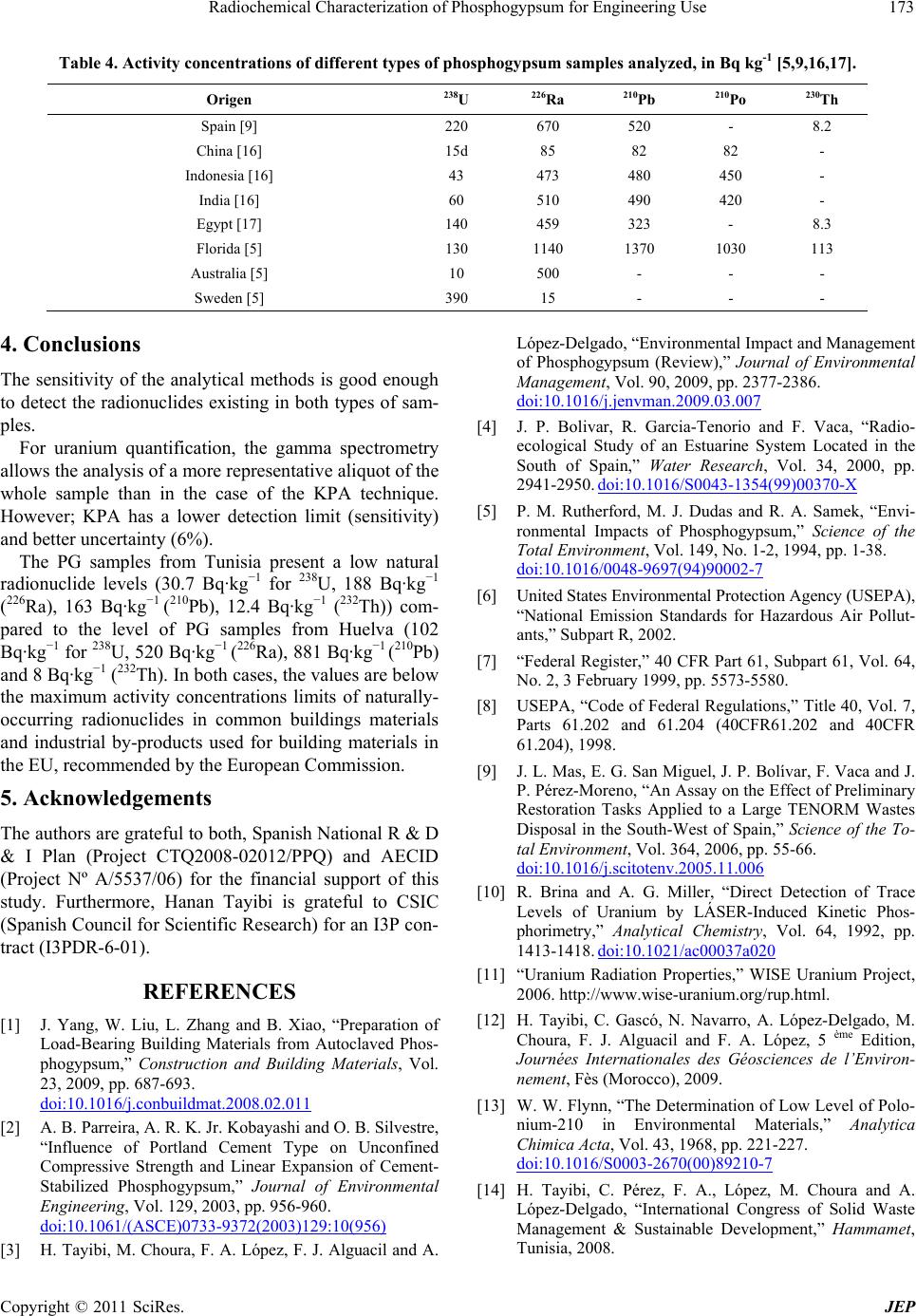
Radiochemical Characterization of Phosphogypsum for Engineering Use173
Table 4. Activity concentrations of different types of phosphogypsum samples analyzed, in Bq kg-1 [5,9,16,17].
Origen 238U 226Ra 210Pb 210Po 230Th
Spain [9] 220 670 520 - 8.2
China [16] 15d 85 82 82 -
Indonesia [16] 43 473 480 450 -
India [16] 60 510 490 420 -
Egypt [17] 140 459 323 - 8.3
Florida [5] 130 1140 1370 1030 113
Australia [5] 10 500 - - -
Sweden [5] 390 15 - - -
4. Conclusions
The sensitivity of the analytical methods is good enough
to detect the radionuclides existing in both types of sam-
ples.
For uranium quantification, the gamma spectrometry
allows the analysis of a more representative aliquot of the
whole sample than in the case of the KPA technique.
However; KPA has a lower detection limit (sensitivity)
and better uncertainty (6%).
The PG samples from Tunisia present a low natural
radionuclide levels (30.7 Bq·kg−1 for 238U, 188 Bq·kg−1
(226Ra), 163 Bq·kg−1 (210Pb), 12.4 Bq·kg−1 (
232Th)) com-
pared to the level of PG samples from Huelva (102
Bq·kg−1 for 238U, 520 Bq·kg−1 (226Ra), 881 Bq·kg−1 (210Pb)
and 8 Bq·kg−1 (232Th). In both cases, the values are below
the maximum activity concentrations limits of naturally-
occurring radionuclides in common buildings materials
and industrial by-products used for building materials in
the EU, recommended by the European Commission.
5. Acknowledgements
The authors are grateful to both, Spanish National R & D
& I Plan (Project CTQ2008-02012/PPQ) and AECID
(Project Nº A/5537/06) for the financial support of this
study. Furthermore, Hanan Tayibi is grateful to CSIC
(Spanish Council for Scientific Research) for an I3P con-
tract (I3PDR-6-01).
REFERENCES
[1] J. Yang, W. Liu, L. Zhang and B. Xiao, “Preparation of
Load-Bearing Building Materials from Autoclaved Phos-
phogypsum,” Construction and Building Materials, Vol.
23, 2009, pp. 687-693.
doi:10.1016/j.conbuildmat.2008.02.011
[2] A. B. Parreira, A. R. K. Jr. Kobayashi and O. B. Silvestre,
“Influence of Portland Cement Type on Unconfined
Compressive Strength and Linear Expansion of Cement-
Stabilized Phosphogypsum,” Journal of Environmental
Engineering, Vol. 129, 2003, pp. 956-960.
doi:10.1061/(ASCE)0733-9372(2003)129:10(956)
[3] H. Tayibi, M. Choura, F. A. López, F. J. Alguacil and A.
López-Delgado, “Environmental Impact and Management
of Phosphogypsum (Review),” Journal of Environmental
Management, Vol. 90, 2009, pp. 2377-2386.
doi:10.1016/j.jenvman.2009.03.007
[4] J. P. Bolivar, R. Garcia-Tenorio and F. Vaca, “Radio-
ecological Study of an Estuarine System Located in the
South of Spain,” Water Research, Vol. 34, 2000, pp.
2941-2950. doi:10.1016/S0043-1354(99)00370-X
[5] P. M. Rutherford, M. J. Dudas and R. A. Samek, “Envi-
ronmental Impacts of Phosphogypsum,” Science of the
Total Environment, Vol. 149, No. 1-2, 1994, pp. 1-38.
doi:10.1016/0048-9697(94)90002-7
[6] United States Environmental Protection Agency (USEPA),
“National Emission Standards for Hazardous Air Pollut-
ants,” Subpart R, 2002.
[7] “Federal Register,” 40 CFR Part 61, Subpart 61, Vol. 64,
No. 2, 3 February 1999, pp. 5573-5580.
[8] USEPA, “Code of Federal Regulations,” Title 40, Vol. 7,
Parts 61.202 and 61.204 (40CFR61.202 and 40CFR
61.204), 1998.
[9] J. L. Mas, E. G. San Miguel, J. P. Bolívar, F. Vaca and J.
P. Pérez-Moreno, “An Assay on the Effect of Preliminary
Restoration Tasks Applied to a Large TENORM Wastes
Disposal in the South-West of Spain,” Science of the To-
tal Environment, Vol. 364, 2006, pp. 55-66.
doi:10.1016/j.scitotenv.2005.11.006
[10] R. Brina and A. G. Miller, “Direct Detection of Trace
Levels of Uranium by LÁSER-Induced Kinetic Phos-
phorimetry,” Analytical Chemistry, Vol. 64, 1992, pp.
1413-1418. doi:10.1021/ac00037a020
[11] “Uranium Radiation Properties,” WISE Uranium Project,
2006. http://www.wise-uranium.org/rup.html.
[12] H. Tayibi, C. Gascó, N. Navarro, A. López-Delgado, M.
Choura, F. J. Alguacil and F. A. López, 5 ème Edition,
Journées Internationales des Géosciences de l’Environ-
nement, Fès (Morocco), 2009.
[13] W. W. Flynn, “The Determination of Low Level of Polo-
nium-210 in Environmental Materials,” Analytica
Chimica Acta, Vol. 43, 1968, pp. 221-227.
doi:10.1016/S0003-2670(00)89210-7
[14] H. Tayibi, C. Pérez, F. A., López, M. Choura and A.
López-Delgado, “International Congress of Solid Waste
Management & Sustainable Development,” Hammamet,
Tunisia, 2008.
Copyright © 2011 SciRes. JEP